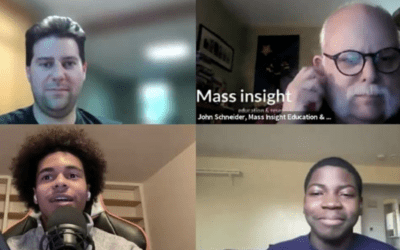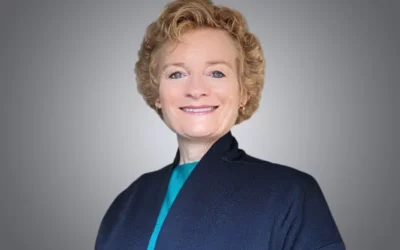A new report by the Voices for Academic Equity Coalition, of which Mass Insight is a founding member, unpacks the status of the state’s MassCore curriculum, a recommended opt-in course of study for the state’s high school students. Massachusetts currently has just...
What The Turnaround Challenge got right about capacity-building — Lesson Six From Revisiting the Turnaround Challenge
This is the sixth of seven blog posts that will highlight the key points in Mi’s recent report, Revisiting the Turnaround Challenge. The report examined the outcomes of three “turnaround zones” implemented by urban public school districts in partnership with Mi between 2012-2019. Our goal was to learn from our past work to help school and district leaders and State Education Agency staff accelerate pandemic recovery in low-performing schools and begin the difficult task of reinventing public education to better serve systemically marginalized students.
The Turnaround Challenge maintains that building staff capacity is a critical component of effective turnaround, and the districts we studied approached the task of ensuring schools hired and retained highly effective teaching staff differently. Two zones pursued a strategy sometimes called teacher and principal replacement, or planned turnover. These zones hired new zone school principals and secured approval from their educators to permit zone school teachers to transfer to another school before zone implementation began, ensuring remaining zone staff were invested in and ready for transformational improvement.
These zones coupled these structural changes with different strategies for improving the effectiveness of the teachers and principals remaining at or moving into zone schools. One district used a competency-based hiring process to improve the overall effectiveness of the teacher and principal workforce in zone schools. The other district changed dismissal policies in order to more easily exit ineffective teachers from zone schools, but contextual factors delayed the zone’s ability to operationalize dismissal waivers as planned.
The competency-based approach appeared more closely correlated to better student outcomes. Zone schools in the first district experienced statistically significant improvement in student test scores during implementation years two and three, while test scores in the second district did not change significantly during implementation where planned turnover occurred. These findings are consistent with prior research indicating that planned teacher turnover can improve student outcomes but only when turnover quickly stabilizes and improves teacher effectiveness. We prioritize capacity-building in our work.
Since The Turnaround Challenge was released, Mi has worked with numerous partners to implement a variety of solutions to build teacher and leader effectiveness, and our partners most frequently cite improved leadership capacity when describing the impact of our work on their schools and districts. This series has touched on notable examples of this – from school leadership coaching on changing conditions in Allentown, PA and implementing tailored solutions in Philadelphia, PA to district leadership support for strengthening an inclusive climate in Aldine, TX and improving central office support in Harrisburg, PA to enabling leaders at all levels to align efforts to goals in Evansville, IN. As we look across all of our partnerships, evaluation data highlights the many ways Mi has built the capacity of school leaders to impact school functioning and student outcomes. Leaders we support highlight the following:
- “Working with [Mi staff] and with the leadership team get to the point of understanding what the leader’s role was and rolling out this instructional framework and how to use that framework to support teachers with the instructional feedback.”
- “I know that seems really simple, but I do think that’s helped in terms of capacity, just thinking about how you’re spending your time in a smarter way so that you’re spending more time on high leverage things.”
- “As you know, working in our urban schools, there’s so many priorities, so many objectives. It’s helpful to be able to get clarity on what are the big rocks versus the small rocks, and I think Mass Insight provided me with a clear direction on what the big rocks are, so that way I can address those priorities first.”
- “Having those conversations about, ‘This is working, Keep moving along.’ Or ‘Hey, what can we do, what can we look into? What partnerships are out there that might be positive for your school?’ Just having those honest conversations I think has really been good for my leadership ability.”
While The Turnaround Challenge may not have gotten everything right, it did get this right: capacity building is essential to any school transformation effort. To this end, Mi partners with schools, districts, and state agencies nationwide to improve leadership capacity.
Click here to read the next blog post in this series.

Recent Posts
The Boston Globe: Step up for Providence schools, former superintendent asks every Rhode Islander
In this op-ed for Globe Rhode Island, Mass Insight's Susan Lusi writes that education in Providence is in crisis and asks Rhode Islanders to support a special commission’s recommendations to move the city's schools forward. Read the full op-ed from The Boston Globe...
An Interview with Mass Insight AP Students and their Teacher
https://youtu.be/mQTeW8-sX40 We sat down with two Mass Insight AP STEM & English Program students, Ben and Chris-Ander, and their teacher, William Pellegrino, to hear about their educational journeys, their experiences in AP classes and as vocational students, and...
You may also like
An Interview with Mass Insight AP Students and their Teacher
https://youtu.be/mQTeW8-sX40 We sat down with two Mass Insight AP STEM & English Program students, Ben and Chris-Ander, and their teacher, William Pellegrino, to hear about their educational journeys, their experiences in AP classes and as vocational students, and...
An Interview with Kristen Hengtgen of The Education Trust
https://youtu.be/1ZfxNShHJOU?si=d1a1GoVrgrDWT5Cu Kristen Hengtgen, Ph.D. is a senior analyst on The Education Trust's P-12 policy team and co-author of their new report, Increasing Access to Advanced Coursework in Massachusetts. In this interview, she joins Mass...
Creating the conditions for greater success of systemically disadvantaged students in AP: Next steps for the Massachusetts AP STEM & English program
Recently the New York Times published an article entitled, Why is the College Board Pushing to Expand Advanced Placement? The article focuses on an important issue: there’s been greater growth in AP participation for Black and Latino students and students living in...



